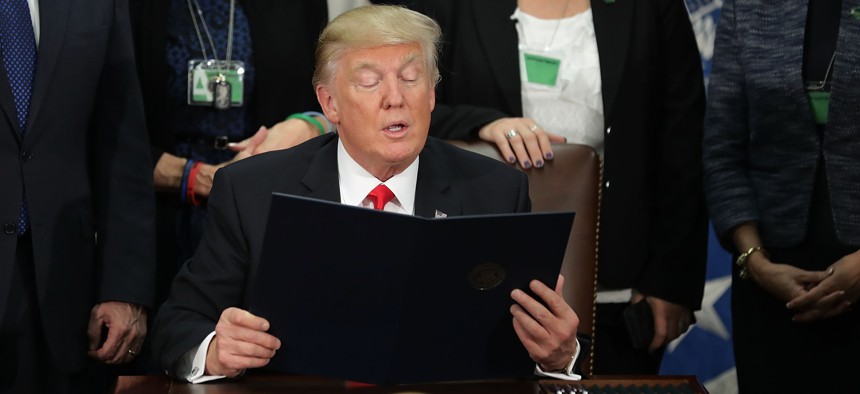
United States President Donald Trump (C) reads from one of the four executive orders he signed during a visit to the Department of Homeland Security January 25, 2017 in Washington, DC. Chip Somodevilla/AP
Trump Orders Halt to ‘Catch and Release,’ But There’s a Catch
Ending the practice of releasing illegal border crossers before they can be deported is easier said than done.
Among the long list of directives included in the executive order President Trump signed on Wednesday on border security and immigration enforcement was a provision to end the practice known as “catch and release.”
Specifically, the order directs the secretary of Homeland Security to “immediately take all appropriate actions to ensure” that any non-citizens caught in the country in violation of immigration law be apprehended until they can be deported:
“The Secretary shall issue new policy guidance to all Department of Homeland Security personnel regarding the appropriate and consistent use of lawful detention authority under the INA, including the termination of the practice commonly known as "catch and release," whereby aliens are routinely released in the United States shortly after their apprehension for violations of immigration law.
It sounds simple enough, but it’s a problem lawmakers and Homeland Security officials have struggled to cope with for more than a dozen years. Back in 2004, Government Executive highlighted the myriad challenges inherent in arresting and detaining immigrants, adjudicating their cases and then deporting them. It takes a lot of skilled personnel—law enforcement officers; detention facility operators; immigration judges, of which there is a severe shortage; and a deportation force—all of which costs a lot of money.
In October 2005, then DHS Secretary Michael Chertoff noted that parts of the immigration control system had “nearly collapsed under the weight of the numbers” (at the time, 80 percent of non-Mexicans apprehended at the border were released because there was simply no place to put them. Twelve years before Trump signed today’s executive order, Chertoff called for an end to catch and release, promising to replace it with a "catch and return" policy:
"Our goal at DHS is to completely eliminate the 'catch and release' enforcement problem, and return every single illegal entrant—no exceptions," Chertoff said.
That obviously didn’t happen. DHS has never had the workforce or the budget to adequately enforce immigration laws given the department's many other responsibilities. Whether the Trump administration will succeed where others have failed—which means prodding Congress to appropriate more money for administrative law judges, detention facilities and law enforcement personnel—is yet to be seen. But it will take more than the stroke of a pen to end catch and release.




